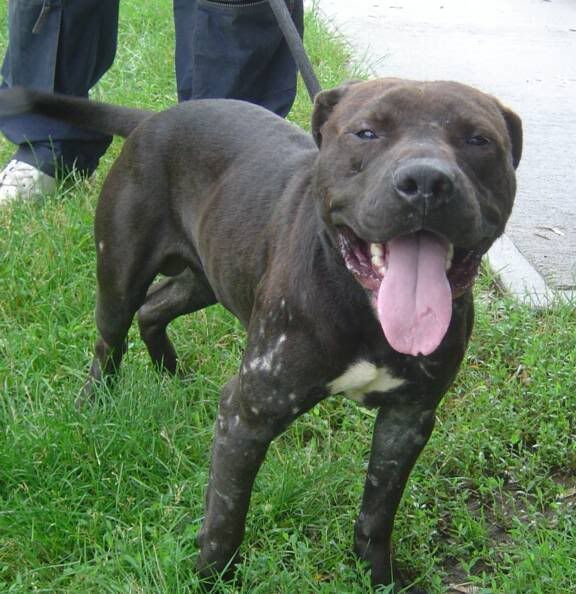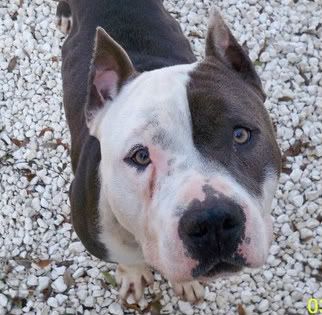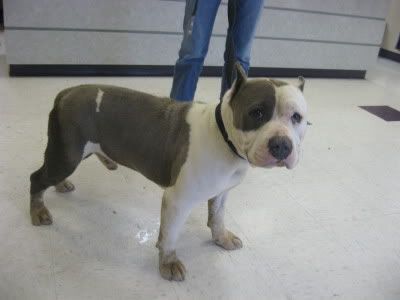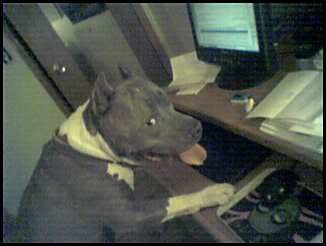There was a video clip from a(n) (in)famous TV trainer's show floating around the internet recently. I had the misfortune of viewing this clip (oh, the 'joys' of needing to be up-to-date on all the news and happenings in the training and Pit Bull advocacy worlds!), and quite literally was horrified. This TV show had hit a new low. The clip showed two Pit Bulls fighting, one dog latched onto the other's lip. The people supposedly in charge were absolutely not, and I cringed in sympathy for the dogs involved in this disaster.
While the star of the show is supposedly both a Pit Bull advocate and someone who knows about "rehabilitating" aggressive dogs, nothing about this clip should have convinced anyone he was either of those things. The dogs were completely set up to fail - a dog with known issues let loose among a group of other dogs, with the star rattling on about how such a situation was likely to trigger a fight (DUH!). Surprise-surprise, a fight breaks out. To make matters worse, the camera person makes sure to capture all the chaos, a close-up of one dog latched onto the other's lip, and "demonstrating" the apparent persistence of a Pit Bull once it grabs onto another dog. Just the sort of exposure the breed needs, right? I can't imagine any true Pit Bull advocate being ok with this sort of footage airing.
I won't link the video here because the last thing I want to do is give this charlatan any more exposure (plus yes, the clip shows the breed in a really bad light), but it was just another in a long line of crappy "rehabilitation" efforts demonstrated on this dude's show. Time and again, this program demonstrates how to set dogs up for failure, teach them to practice bad behavior, then beat them for doing exactly what you'd expect them to do (bite or fight) in the given scenario.
The reason I bring this up is to point out the WRONG way to do things, and contrast this with the RIGHT way. The
right way may not be exciting or dramatic enough for a TV program, but it is humane and effective - which is way more important!
Over the weekend I had the pleasure of attending an Emma Parsons seminar. Emma is the creator of the
Click to Calm method of modifying aggressive behavior in dogs (particularly dogs aggressive to other dogs). Unlike you-know-who mentioned above, Emma's whole goal as a trainer and behavioral consultant is to set the dog up to SUCCEED. What does that mean, exactly? It means the dog is put in situations where he or she has the opportunity to learn appropriate behaviors and NOT PRACTICE aggressive behaviors.

Those who understand behavior and learning understand that the more an animal gets to "practice" (and hence gain reinforcement for) a behavior, the more difficult it is to eliminate that behavior. So the earmark of any good behavior modification program is that it always sets the dog up to 'do the right thing' and NEVER EVER purposely sets a dog up to fail (IE. practice aggression).
The seminar also included demonstrations of the Click to Calm method on real, live aggressive dogs. During two days worth of demonstrations, there was NOT ONE aggressive outburst. Emma is so skilled at working dogs at their comfort levels while also teaching them new and better ways to behave as she gradually increases the difficultly level, that no dog felt threatened or the need to aggress or bite. All the dogs learned new skills and coping mechanisms, and none of the dogs got to practice aggressive behavior. They all stayed calm, and in a state conducive to learning.
What many fail to realize, is that aggression is always about making some scary or uncomfortable thing go away. That old
"alpha dog" theory has been thrown away, and we now know that dogs aren't trying to "dominate us" when they aggress. Dogs who aggress are seriously stressed, frightened, uncomfortable, in pain, or fearing for their safety. To put a dog in a
stressful environment that actually induces an aggressive reaction, then yank, jerk, alpha-roll, or string up the dog for aggressing, is abusive and most CERTAINLY not training or behavior modification.
Don't fall for the charade of a "rehabilitator" who is constantly pushing dogs to the chaotic points of extreme stress and aggression! Proper behavior modification is about making a dog feel safe, comfortable, and proving to him or her that there is no need to aggress. This is done through positive experience, gradual exposure, teaching new behaviors, and SETTING THE DOG UP FOR SUCCESS at each step along the way. Training and behavior modification sessions should be calm, gentle, and relaxed.
































